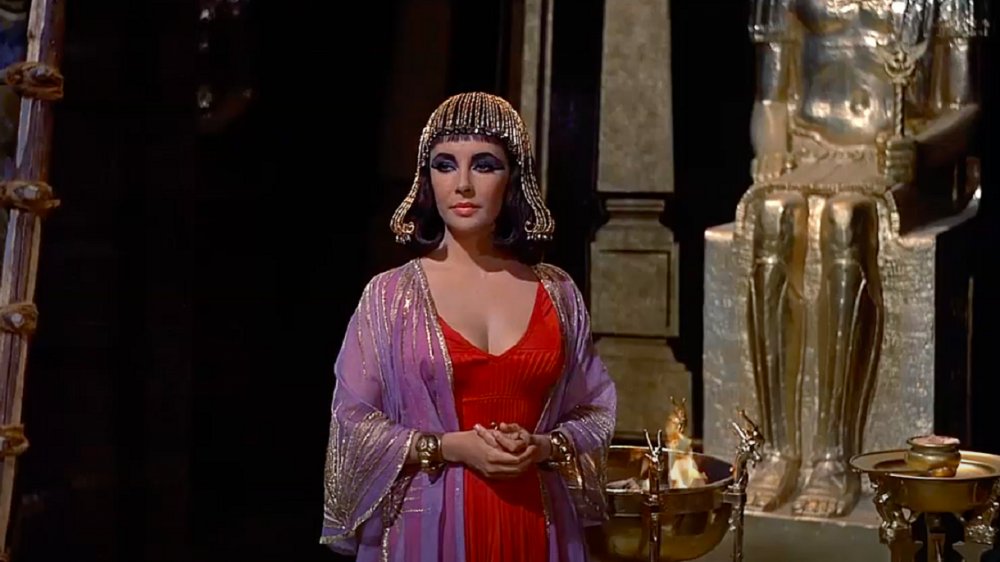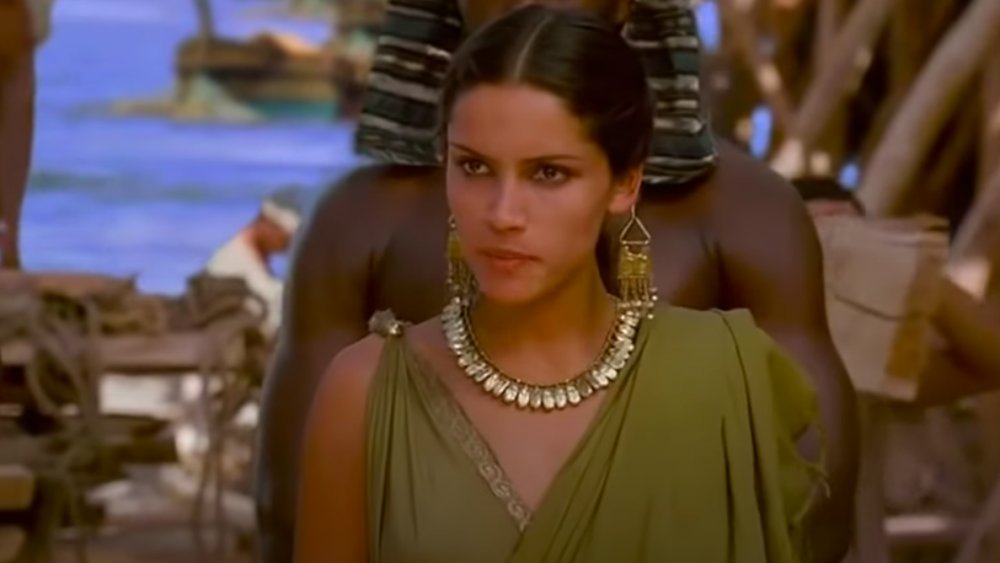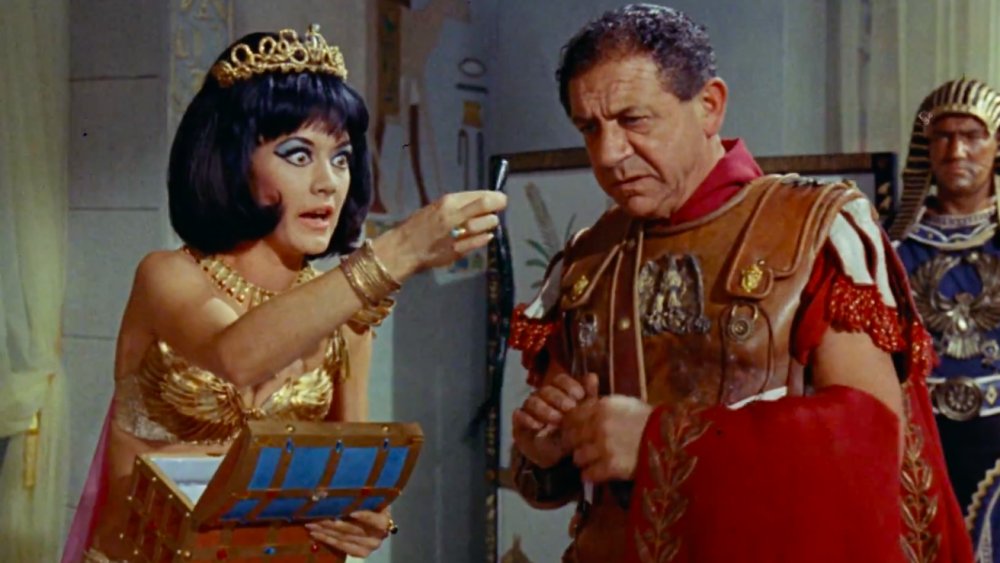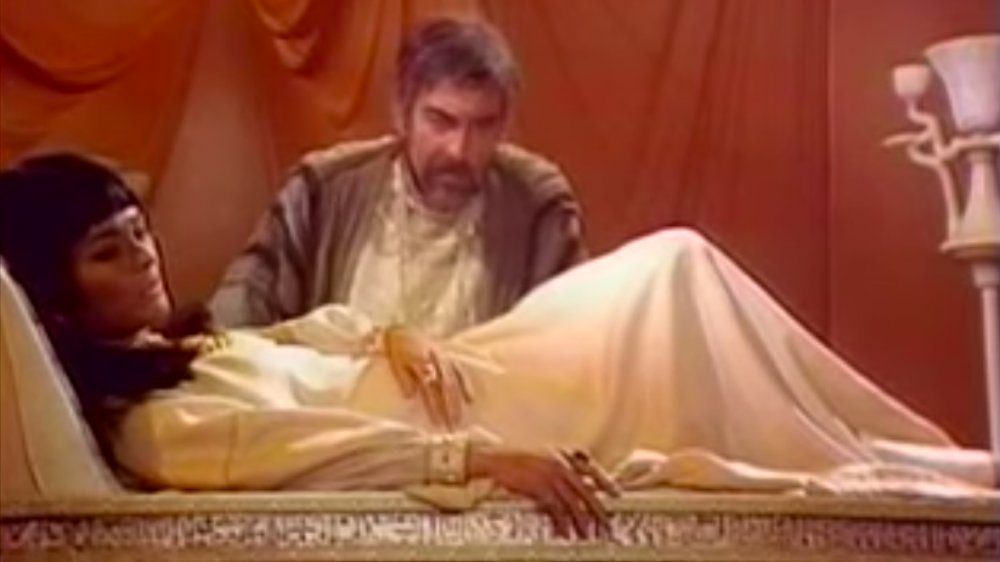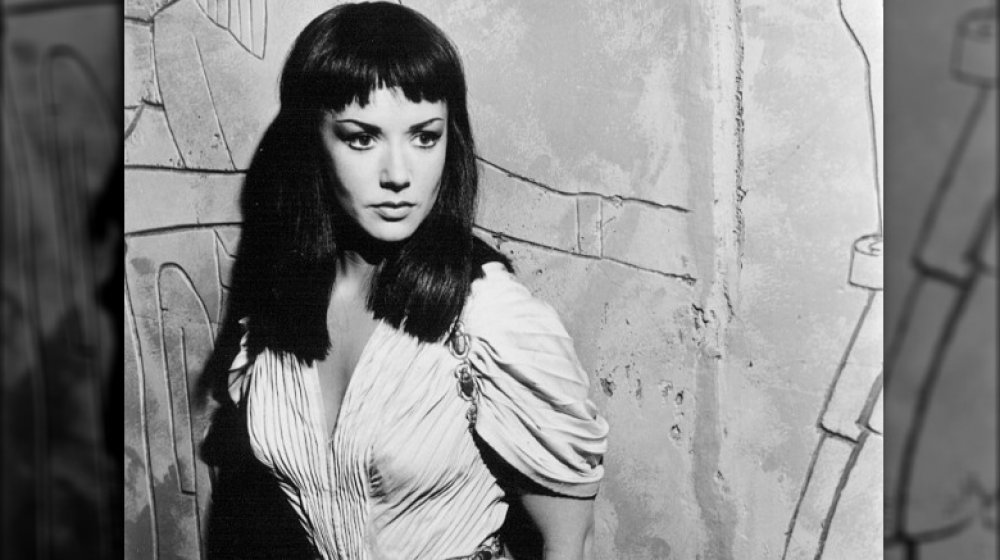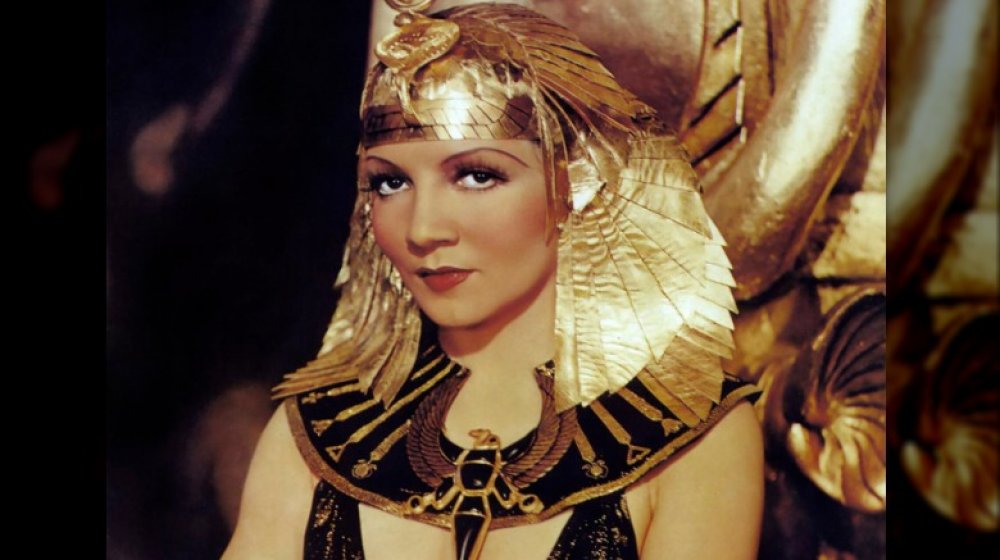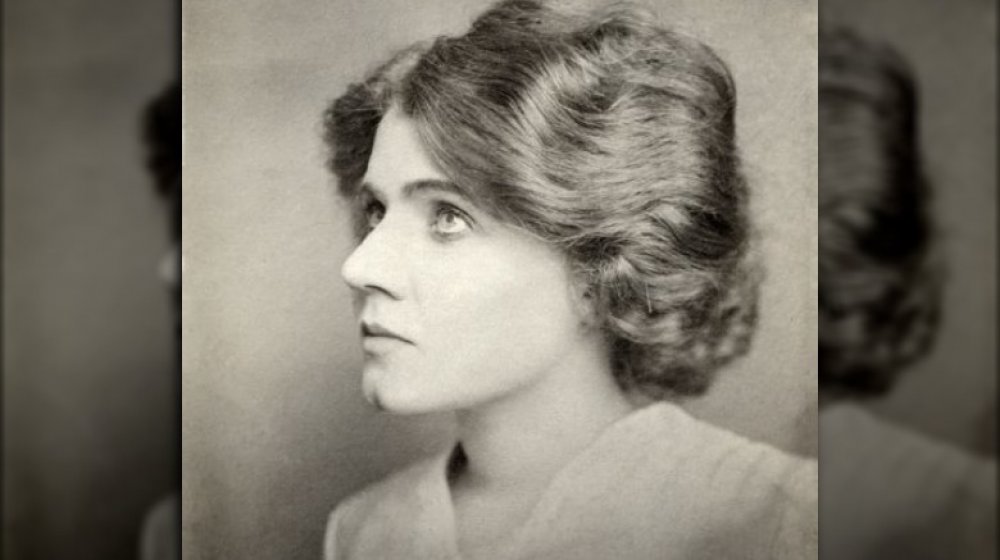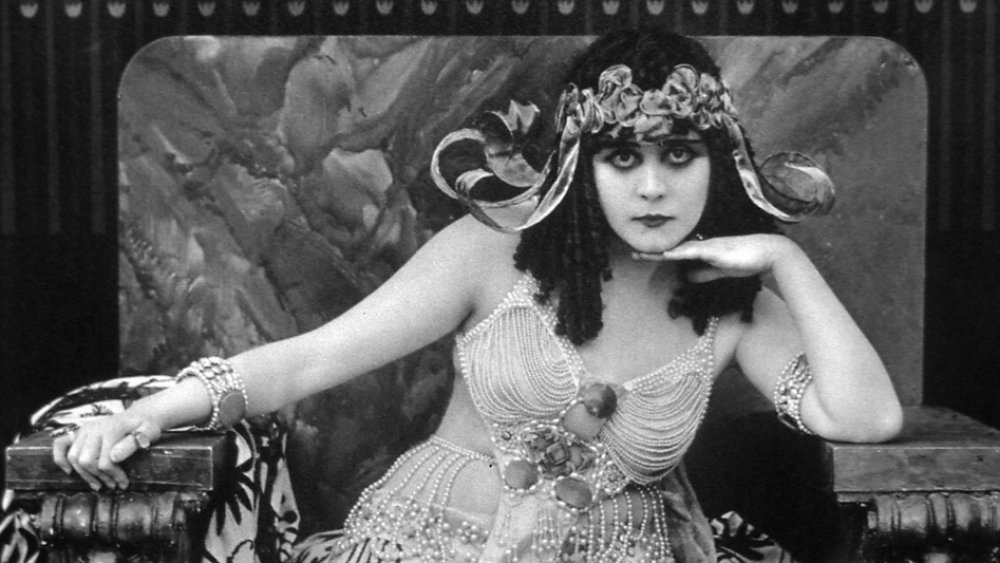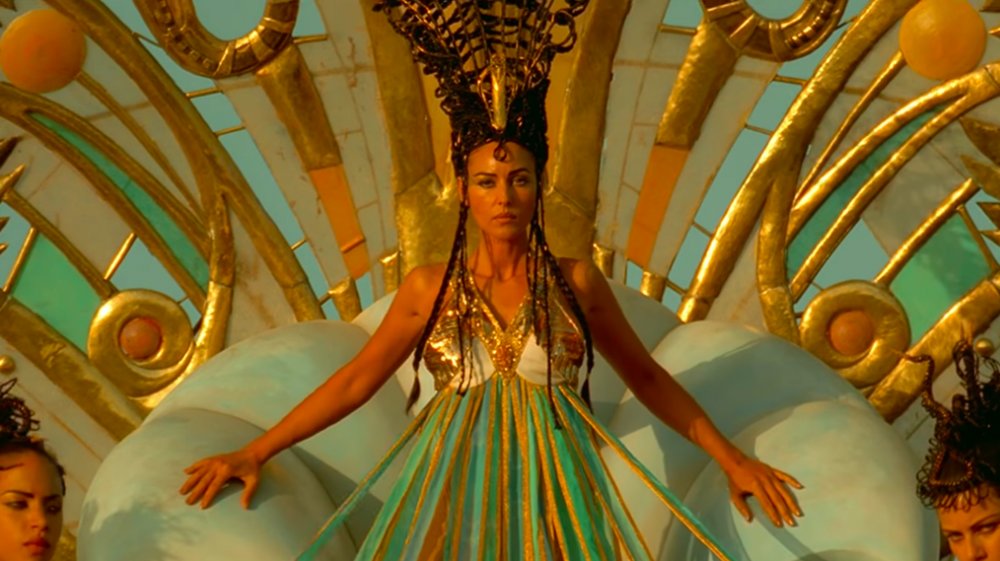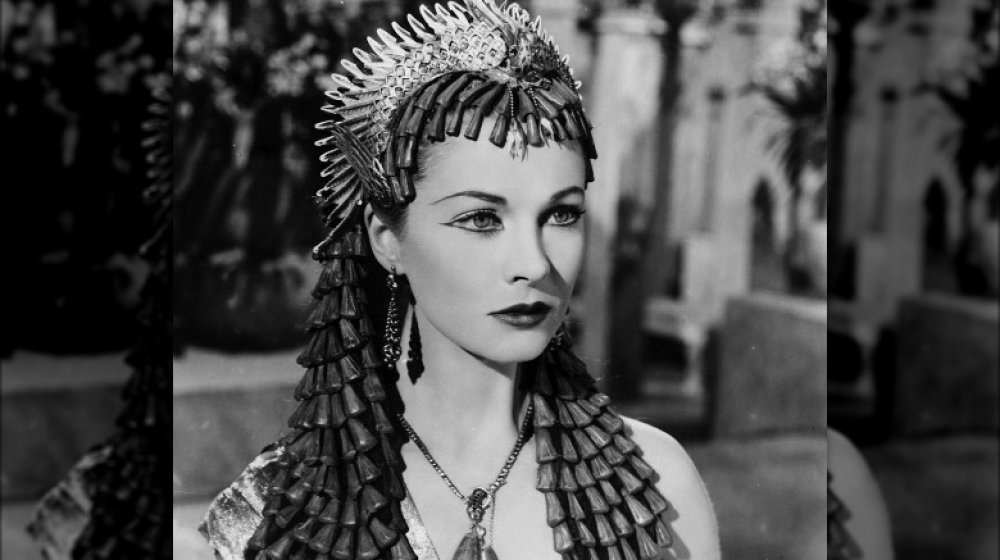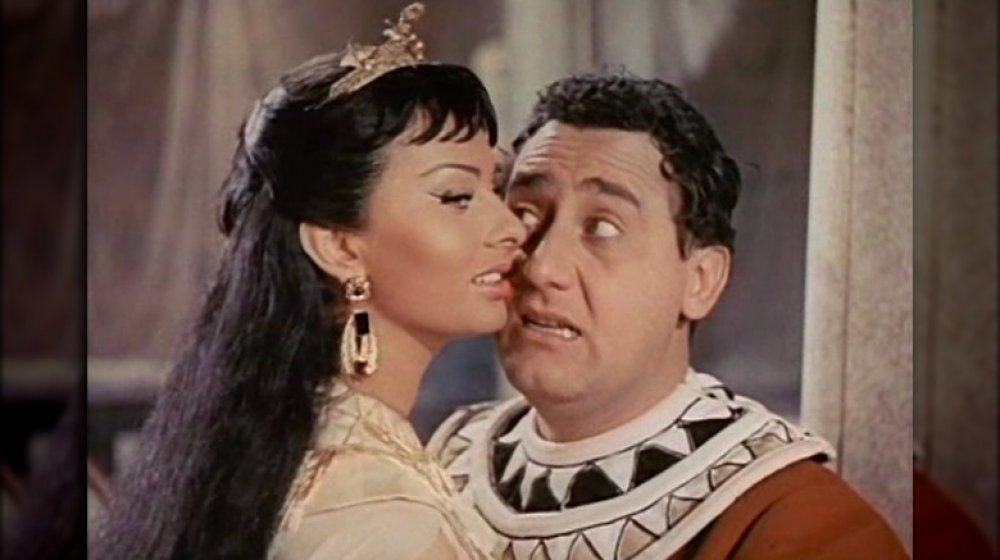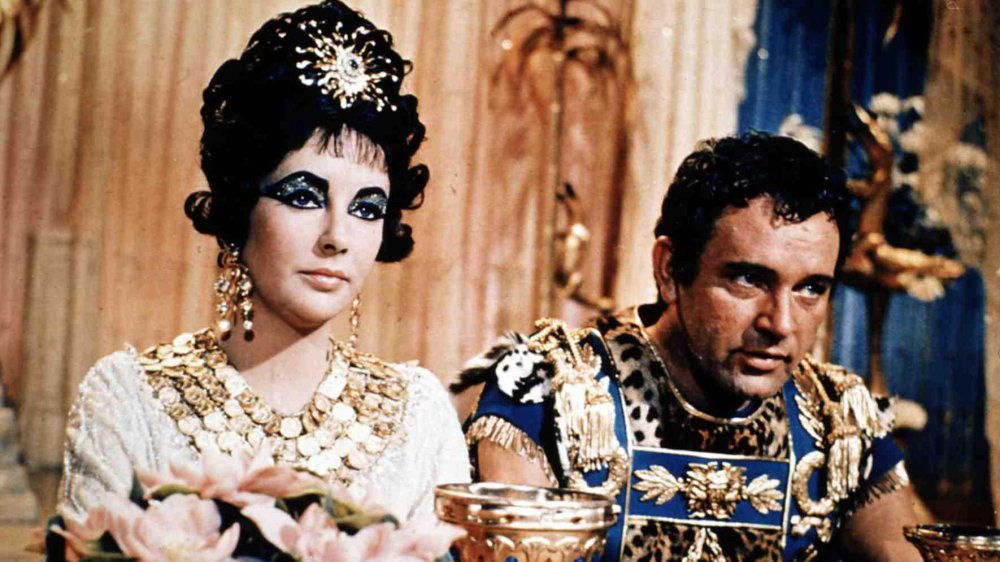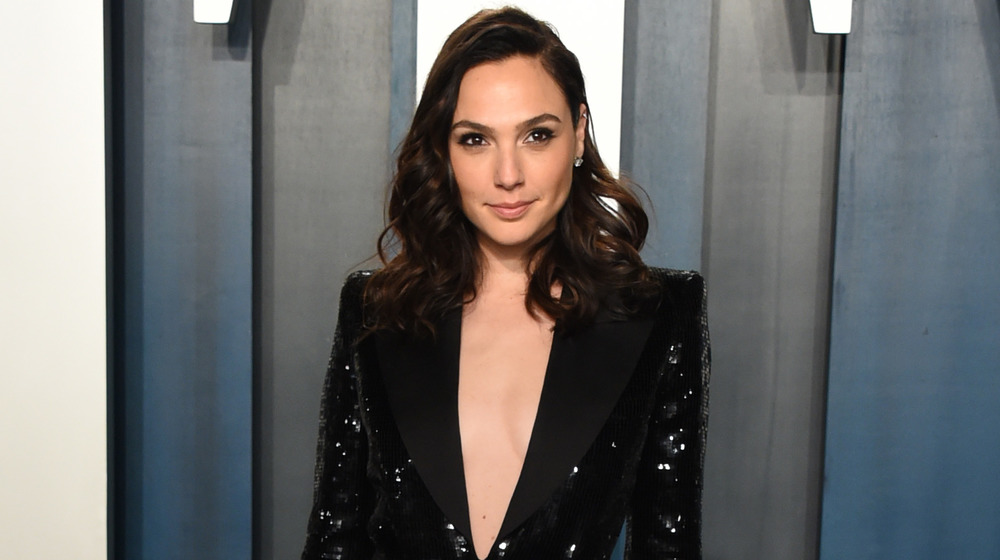The Best Portrayals Of Cleopatra On Screen Ranked
Cleopatra, the commanding and impressive queen of the Nile, acted as the ruler of Egypt during the 1st century B.C. and has since become an instantly recognizable part of pop culture. She's inspired a Shakespeare play, been in countless flicks and TV series both bad and good, and even served as influence for the most bizarre music videos (yeah, Katy Perry, we're looking at you).
While many have often wondered what Cleopatra looked like, Hollywood has taken the approach of portraying her as a breathtaking beauty. However, according to Smithsonian Magazine, that may not have been the case. A "coin bearing a portrait of Cleopatra" was discovered in 2007 dating back to 32 B.C., "[showing] a rather homely Cleopatra with a large nose, narrow lips and a sharp chin." As the mag notes, "ancient historians never characterized Cleopatra as a great beauty, and in her time she was not considered a romantic heroine." Thankfully, for fans of cinema, Tinseltown tends to embellish the truth.
As the Pittsburgh Post-Gazette wrote in 2000, "Cleopatra holds [the] title of longest-running screen siren." That being said, it takes more than slapping on some kohl eyeliner, a blunt bob for a wig, and calling it a day. We've rounded up the best portrayals of Cleopatra on-screen, ranking them from those that aren't too memorable to the ones we'll immediately recognize.
Leonor Varela looked the part, but beauty wasn't enough
While Leonor Varela's name may not necessarily ring a bell, fans of the Blade trilogy will recognize her as Wesley Snipes' sworn enemy in Blade II, the vampire Nyssa. Playing a seductress was clearly easy for the Chilean beauty, and in 1999, she snagged the titular role in Cleopatra, a three-hour mini-series that was even nominated for four Primetime Emmy Awards.
Critics were a bit harsh though, with The New York Times declaring, "It's big, it's bad, it's Cleopatra! What else could anyone expect?" As the outlet ruthlessly went on, "This version strains so hard to make her an overachieving modern woman that she might as well have a to-do list taped to her throne." On the other hand, New York Magazine was a bit more forgiving to the $30 million production, adding that Varela, being half Chilean and half French, is "exotic enough not to need additives of kohl or lacquer." Instead, the actress delivered her lines "dark-eyed, olive-skinned, raven-haired, and lithe-limbed."
Varela makes the bottom of this list, proving that looks aren't all to get by as the queen of the Nile. If you do, however, feel like sitting through three long hours of this mini-series, you'll spot Billy Zane (known for his role as the hunky douchebag from Titanic) playing Mark Antony, set on avenging Julius Caesar's death.
Amanda Barrie had the help of some very famous costumes
Amanda Barrie took a lighthearted approach to starring as the queen of the Nile in 1965's Carry on Cleo. The flick, which is part of the Carry On series, spoofs Antony and Cleopatra, or as the film itself says (via DCA), it's based on "an idea by William Shakespeare." The movie is worth taking a peek at if anything because it reused the set and costumes from 1963's iconic Cleopatra starring Elizabeth Taylor – meaning "the production values are somewhat higher than usual."
Longtime British soap fans may recognize Barrie from Coronation Street, but the comedian first catapulted into the spotlight thanks to the Carry On movies. So, what did the reviews say? Across the pond, The New York Times dubbed it a "cheap travesty," adding that "it is burdened with some of the most atrocious gagged-up dialogue." Perhaps we can chalk this review up to the English having a different sense of humor, as The Guardian offered up praise, writing, [Carry on Cleo] "gets it right on the money when it comes to the sense of humor on the Nile in the first century BC."
As for Barrie? There's no denying Carry on Cleo gave the actress some Tinseltown publicity, with actor Richard Burton even declaring (via The Oldie), "My God, the girl who plays Cleopatra in Carry On Cleo is sexier than [Elizabeth Taylor]."
Janet Suzman was a Shakespearean heavyweight
Janet Suzman played a sultry Cleopatra in the Royal Shakespeare Company's TV movie, Antony and Cleopatra, in 1974. The flick was received well by the British Academy of Film and Television Arts, earning director Jon Scoffield an award for Best Single Play, while Suzman herself got a BAFTA nomination for Best Actress.
The starlet is truly mesmerizing to look at as the queen of the Nile, and as it turns out, she was already an acting heavyweight at the time. As The Guardian wrote years later in 2011, "Janet Suzman was one of the giants of the British stage in the 60s and 70s," adding that she was even poised for Hollywood — yet never made it. Starring in a plethora of Shakespearean roles throughout the '60s and '70s such as "Kate in The Taming of the Shrew, Portia in The Merchant of Venice and Ophelia in Hamlet," the actress mused to the outlet that she believes Tinseltown is "conservative." Elaborating, Suzman explained, "If you've worn a tiara, they are always looking for tiara parts for you."
It looks like playing Cleopatra really left a mark on Janet Suzman, as in 2011, she decided to step back into the ruler's sandals — yet this time as a director. As noted by The Guardian, Suzman directed Sex and the City's Kim Cattrall as Cleopatra in an on-stage production of Antony and Cleopatra at the Liverpool Playhouse.
Piper Laurie, Hollywood's 'cute ingenue'
Hollywood legend Piper Laurie once slapped on her best winged eyeliner for her role as Cleopatra in an episode of General Electric Theatre titled "Caesar and Cleopatra." The actress — who in the '90s became a household name thanks to her role as the cunning Catherine Martell in Twin Peaks — was still at the start of her career in 1959 when she landed the part of the Egyptian ruler. As Flavorwire notes, she wore "a chic, long black bob," and kept things simple with one prop: "a white kitten."
While the TV show hosted by then-actor Ronald Reagan had generally positive reviews, it truly put Laurie on the map, who would then go on to receive her first Academy Award nomination for The Hustler in 1962, along with starring as the religious fanatic Margaret White in the now-cult horror flick, Carrie, in 1976.
However, before she became instantly recognizable on the silver screen, Piper Laurie was climbing the Tinseltown ladder, and in the '50s during her General Electric Theatre debut, she was cast "in a string of frothy romances" (via People). As the outlet explained, Laurie "enhanced her cute ingenue image by telling the press that she took milk baths and ate gardenia petals for lunch." Hey, Cleopatra herself supposedly did the same, so it must be worth something, right?
Claudette Colbert added a sprinkle of feminism to her role
Claudette Colbert, one of the highest-paid Hollywood stars of the 1930s, took on the titular role in Cecil B. DeMille's 1934 epic, Cleopatra. By then, Colbert was already a sultry A-lister, known for her "impeccable makeup, trademark bangs, and stunning legs" (via Vanity Fair), so it made sense she take on the part of the extravagant Egyptian ruler.
It wasn't the first time Colbert worked with the legendary DeMille, either. As Vanity Fair explains, she also starred as "Poppaea, Emperor Nero's lascivious wife," in the director's 1932 historical drama, The Sign of the Cross. Teaming up again for Cleopatra, DeMille's flick "cost about $1,000,000 to produce, employed 5,000 people, [and] was 14 months in the making" (via Vanity Fair). So, how was Colbert in the role? As Cinemagraphe notes, this version of Cleopatra involved some seriously cool Depression-era feminism, with Colbert playing "a gal who can take anything life throws at her, and whose own suicide is played as a clever triumph over one more foolish Roman."
Nevertheless, the same year she wrapped up Cleopatra, Claudette Colbert was done being typecast as a Hollywood lush. When she starred in 1934's It Happened One Night, the starlet finally put her foot down. According to The New York Times, Colbert allegedly "refused to even partially undress before the camera. She wanted to feature her acting, not her sex appeal."
Florence Lawrence, 'the first movie star'
One of the first portrayals of Cleopatra on the silver screen comes from Canadian actress Florence Lawrence, in 1908's Antony and Cleopatra. The star of over an astonishing 270 films, Lawrence is, by many, considered "the first movie star," one that understood she could use her celebrity power "to promote her films" (via History).
According to Vanity Fair, Lawrence "began her acting career without fanfare in 1906." Interestingly enough, by 1909, although she appeared in around 50 flicks, she wasn't known by name — instead solely as "the Biograph girl" (after D.W. Griffith's Biograph Company, whom she worked for). So, why not credit Florence Lawrence appropriately? As it turns out, this trend began in Thomas Edison's studio, "who feared that notoriety would embolden actors to demand more money."
When Lawrence died in 1938, she was buried at the Hollywood Forever Cemetery, yet remarkably, "her grave went unmarked from 1938 to 1991." As for her part in Antony and Cleopatra? Thanks to the Edison Trust cartel, we're not even entirely certain Lawrence played the part of the Egyptian ruler. As Florence Lawrence, the Biograph Girl explains, "she may have been film's first Cleopatra or she may have played the Egyptian's maid [...] nevertheless [Lawrence] was proud of her work." In 1910, Florence Lawrence "became the very first actor to receive a film credit." Lawrence remains an integral part of Hollywood history, and in turn, an on-screen Cleopatra essential.
Theda Bara's haunting Cleopatra
Theda Bara's interpretation of the queen of the Nile in 1917's Cleopatra is haunting — if only because a few seconds of it remain for viewing. According to The National, although Florence Lawrence's 1908 portrayal came first in Antony and Cleopatra, it's Bara's depiction "whose fame endures today."
"Hollywood entertainment has certainly developed amazingly since I was making pictures," the legendary silent star mused on a radio show in 1936. "Before pictures grew up and started to talk, we had to translate all emotion into pantomime [...] We had to express jealousy, hatred, love, or devotion all in pantomime, and at the same time, keep pace as the director guided us." Talking specifically about her role in Cleopatra, Bara notes, "We had no research department at the studio. I worked myself for months with a curator of Egyptology at the Metropolitan Museum in New York."
Sure enough, Bara definitely made a lasting impression on the cinematic world starring as the Egyptian ruler. "Without being able to see the complete film, it's often hard to understand what all the fuss was about," explains Michael Pogorzelski, director of the Academy Film Archive in Fragments: Surviving Pieces of Lost Films. "In 1915, Theda Bara was an overnight sensation upon the release of her first film, A Fool There Was. She became famous as 'the vamp.'" As Pogorzelski so perfectly summarizes, "In essence, she was the silent screen's first sex symbol [...] her most famous role was as Cleopatra."
Monica Bellucci's costumes were glam enough to steal
Italian bombshell Monica Bellucci decked herself out in the glitziest of costumes for 2002's French flick, Asterix and Obelix: Mission Cleopatra. As Hello! Magazine notes, at the time of its release, the movie was "the most costly European film of all time and no expense [had] been spared either on the special effects or on the costumes." So, what exactly did Bellucci wear? According to the outlet, designers Philippe Guillotel and Tanino Liberatore styled nine dresses for the starlet, with "the standout" being "a spectacular black gown adorned with 5,000 pearls."
However, as much of a "standout" as the black gown was, it wasn't what caught the eye of a French waiter at the Cannes Film Festival in 2003. According to Reuters (via Entertainment Weekly), a hotel worker stole one of Bellucci's dresses, or more specifically, a $180,000 gown "spun from gold thread," which was on display at the Martinez Hotel. As the site writes, the waiter "confessed to stealing the costume as a gift to impress two girls he had met hours earlier." Uh, mission accomplished?
While critics dubbed the movie amusing while it lasted, it's the Italian actress who commanded all the attention — or as Variety put it, "Monica Bellucci's asset-enhancing costumes afford some of the nicest views in the ancient world."
Vivien Leigh was 'ruthless' as Cleopatra
Vivien Leigh, once Hollywood's "It" girl thanks to her 1939 performance in Gone with the Wind, had a whirlwind of a time filming 1945's Caesar and Cleopatra, an over-the-top production fraught with problems.
As the Daily Express detailed after the flick's release, the World War II production took over two years to complete and "cost nearly £1,300,000" — at the time making it "the most expensive British film ever produced" (via The Criterion Collection). Shot within three elaborate sets (yet with real imported Egyptian sand, nonetheless), money wasn't the only problematic issue to arise. Per Harper's Bazaar, Leigh was "diagnosed with tuberculosis in her left lung" before filming began and was "advised to stop acting." Nevertheless, the actress took on the ambitious role, even suffering a miscarriage on set after she slipped and fell. As the magazine notes, "This sent her into a deep depression, and Leigh was so distraught that she would sometimes fall into hysteric crying fits on the floor."
Along with Leigh's health problems, the set was home to the occasional buzz-bombs being dropped in the surrounding area (via Daily Mirror) and weather issues (this was England, after all). As for the end result? Per AnOther, "the film was a relative failure at the box office," yet Vivien Leigh captivated audiences with her portrayal as Cleopatra. As the Daily Mirror summarized, "Every woman will sigh to be so ruthless in such glorious clothes."
Sophia Loren's Cleopatra sizzled for decades
Before she became a silver screen icon, Sophia Loren starred as Cleopatra in the Italian comedy, Two Nights with Cleopatra in 1954. As Biography notes, that same year, she took on yet another leading role in The Gold of Naples, establishing herself "as one of the up-and-coming stars of Italian cinema."
While the film itself didn't exactly garner overall positive reviews, it solidified Loren as a bonafide international sex symbol. As Marie Claire wrote of her performance, "the stunning Sophia shines." Interestingly enough, according to Shakespeare and the Cleopatra/Caesar Intertext, Two Nights with Cleopatra wouldn't get released in America until the '60s, where audiences were drawn to see a then-18-year-old Loren in one of her earliest roles, with one trailer calling her "The screen's queen of romance."
Decades later, Sophia Loren's influence through her sultry look and fashion sense has still found its way into pop culture. In fact, per People, Kim Kardashian's now-famous "wet" 2019 Met Gala outfit is said to have allegedly drawn inspiration from Loren's first American feature-film debut in Boy on a Dolphin, where the actress wears (quite literally) a "sexy wet dress."
Elizabeth Taylor, film's most iconic Cleopatra
Elizabeth Taylor is, without a doubt, the most famous on-screen Cleopatra. The most expensive flick to date, 1963's Cleopatra "took $44 million (about $300 million today), two directors, two separate casts, and two and a half years of on-and-off filming in England, Italy, Egypt, and Spain," to hit theaters and dazzle audiences (via Vanity Fair).
Taylor's legendary 65 costumes changes aside, it's her on-and-off-screen romance with Mark Antony (played by Richard Burton) that ultimately captivated audiences — as both actors were married to other partners at the time. "Sparks flew between them when they filmed a scene that required her to gaze into his eyes, and an on-set kiss went on for far longer than the production required," writes Biography, adding that their relationship was aggressively volatile, too. At one point, production even stopped for Taylor to recover from two black eyes and a roughed-up nose. "Never before [was a] celebrity scandal pushed so far into global consciousness" (via Vanity Fair).
"Forget the fantastic sum that Cleopatra is reported to have cost. Forget the length of time it took to make it and all the tattle of troubles they had, including the behavior of two of its spotlighted stars. The memorable thing about this picture [...] is that it is a surpassing entertainment, one of the great epic films of our day," wrote The New York Times after its release, and to be fair, it still rings true to this day.
The next Cleopatra
Even after so many centuries have passed, audiences haven't stopped flocking to the story of Cleopatra. In fact, our obsession with the queen of the Nile is so powerful that there's another film in the works.
So, who gets to play Egypt's famous ruler this time? According to the BBC, it's Gal Gadot, who's primarily known for playing Wonder Woman in the DC Extended Universe films. Gadot's casting led to some backlash on social media, with a number of users decrying the choice as yet another instance of "cultural whitewashing" on Hollywood's part.
Even before Gadot (who is Israeli) was cast, debate had raged on Twitter over who should next play Cleopatra. Beyoncé was a popular choice. Notably, as reported by The Oprah Magazine, remains believed to be of Cleopatra's sister, Arsinoe, were discovered in Turkey in 2009, and they revealed that Arsinoe's (and therefore Cleopatra's) mother was African, indicating that Cleopatra may have been dark-skinned.
